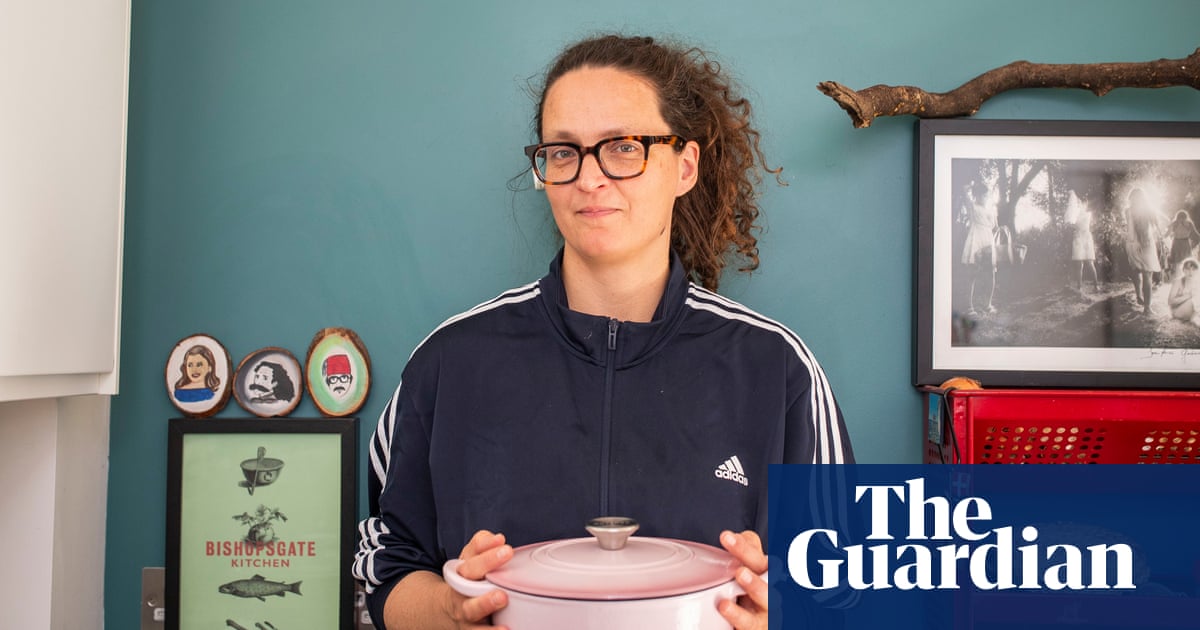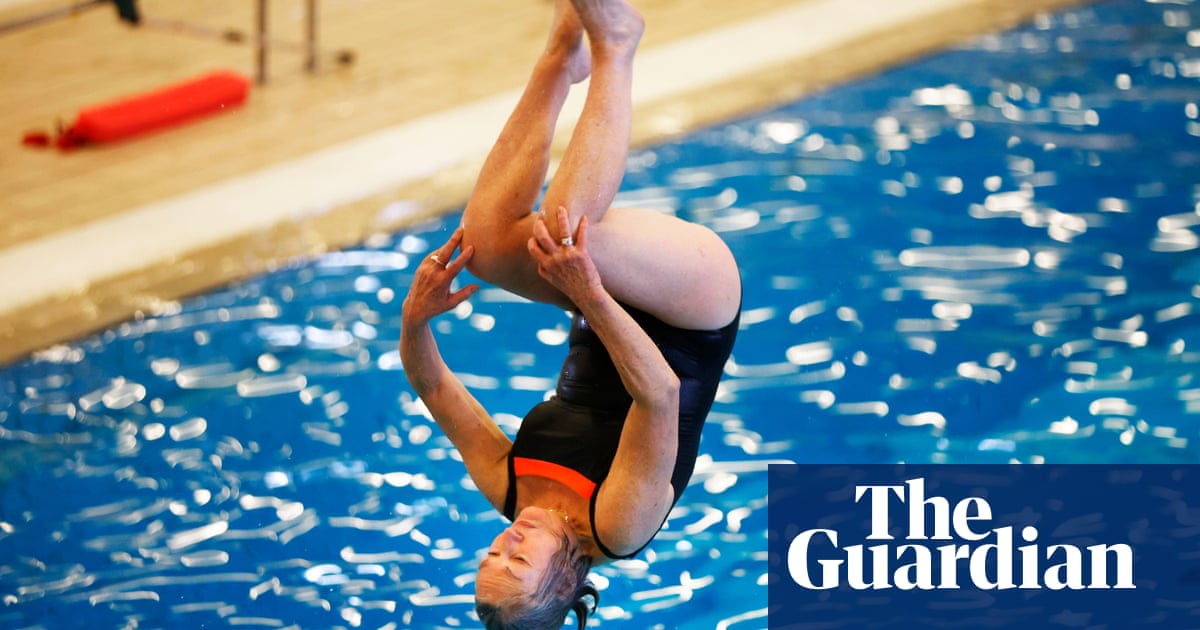Aldi recently launched the new colour range of its budget cast-iron casserole dishes, an annual occurrence since at least 2015. While other retailers including Marks & Spencer, Sainsbury’s, Argos and John Lewis also stock cheap cast-iron, Aldi’s, at £19.99, is by far the cheapest. It’s also only available “while stocks last”.
Any cookbook worth its salt will, at some point, tell you to simmer/boil/fry/saute something in a “heavy-bottomed” pot or saucepan. Contrary to lightweight postwar aluminium fare, a pot with a decent weight to it retains and distributes heat more evenly, ensuring food cooks better (and slower). The ultimate in all-round heavy pots – and kitchen status symbols – come from Le Creuset. Founded by two Belgians in the tiny northern French town of Fresnoy-le-Grand, this foundry produced its first bright orange (a colour known as Flame in Le Creuset parlance) cocottes in 1925. Such was the international engouement they provoked early on, that the company still makes exactly the same products, in the same way.
The coloured enamel exteriors have been central to their appeal from the outset: that original volcanic orange was inspired by the colour of molten metal. Marilyn Monroe had a whole collection in Elysee Yellow that sold at a New York auction in 1999 for $25,300 and cookbook author Elizabeth David, a lifelong fan, inspired a range in Gauloise blue. The latest iterations come in all sorts of colours with names like Berry and Bamboo. Each costs a small fortune.
The last time the French brand held a warehouse sale – in Andover, Hampshire, in November 2024 – the police were called because hard-nosed hopefuls were lining the London Road and the A3093 for miles. One couple, who queued for four hours, TikTokked a massive haul of about 50 items on which, they said, they’d saved £1,614.50 (paying £1,127 instead of £2,741.50 at full price). This included a classic round casserole dish that would have cost them £369 full price, but for which they only paid £159.
It makes perfect sense, then, that supermarkets should be clambering to produce imitation Le Creusets, but finding one of the Aldi cast-iron casseroles is a tricky business. I trekked to the brand’s superstore in Leyton, east London, the day after they were released and unearthed the last two, hidden mid-aisle in the jumbled product bins. They come in one size only – 22cm in diameter, with a volume of four litres – and two colours: Pepto-Bismol pink or night-sky blue.
An Aldi shop assistant told me he’d bought a large blue frying pan in the same range, now completely sold out, a couple of weeks earlier. He was delighted with the purchase and, at that price (a cool £12.99), you would be too. The Le Creuset casserole closest in size (a 24cm / 4.2 litre model) to the Aldi one costs £305. For that amount, you could buy 14 Aldi pots (with change). Or one Aldi pot, and have enough money left over to buy yourself a cheap hob and oven. The question then is: are they any good?
The kitchen test
I have a small Le Creuset cocotte which I use to make things like Marcella Hazan’s slow-simmer tomato sauce or Japanese pork curry. I use it for cooking Japanese rice, too; and as a Dutch oven for baking. I try cooking all of these things in both a pink Aldi number, and a grey M&S medium casserole dish (21.2 cm / 2.8 litre, £35), as a comparison.
I find the Aldi lid doesn’t fit quite as snugly as the Le Creuset’s and the M&S’s – all the steam rushes out of the pot and my rice comes out harder than it should. Other than that, cooking with both pots is comparable to the Le Creuset.
I’ve always associated enamelled cast-iron with gas or fire cooking but these pots work just as well on any other hob, including induction. Leiths cookery school graduate and foodie content creator Tyler Butt has garnered millions of followers on Tiktok and Instagram with homely dishes like shepherd’s pie, made in exactly this kind of casserole dish on – and in – an Aga.
Honey and Co’s Sarit Packer, meanwhile, has a 20-year collection of cast-iron pots and pans at home that she uses on an electric hob. “We love the heat distribution and that they fit in the oven to cook through or just keep warm,” she says. Her absolute best use of the pans, she adds, is to braise a whole chicken with vegetables “and maybe a splash of wine and some spices, simply in a medium hot oven for two hours without paying any attention to it as it cooks. You get a great no-stress dinner for four.”
I don’t roast three whole chickens, but to test the pots in the oven, I do bake a batch of cinnamon rolls in each. Here too, the bakes come out great – no discernible differences.
The mistreatment test
The rules for using a cast-iron pot are simple: don’t heat it up too quickly (a danger particularly on induction hobs), or heat it up dry, without oil or liquid. Don’t use it over a too high heat. Don’t put a hot pan under cold water. Don’t use metal utensils or abrasive cleaners; don’t scrub with metal wool. I’ve definitely, foolishly, ruined a Le Creuset cast-iron milk pan before by not following this guidance. So, that’s precisely what I try to do now, with both the Aldi and the M&S.
I purposely burn the curry and the rice. I scald milk. I melt sugar until it’s black and smoking. I put hot pans under a cold tap, scrape them with knives and metal spoons, and scour them inside and out with metal wool.
The most damage I manage to inflict is a few grey lines on the otherwise beautifully smooth enamel: both still look new. Of course, I didn’t ruin my Le Creuset milk pan in one go, and my extant Le Creuset cocotte I’ve had for over a decade. All of which suggests that the real test will be how these cheapos fare in time.
Neil Currie, the co-founder of Shropshire’s Netherton Foundry, started designing cookware and appliances straight out of art school in 1981. He worked for both Lidl and Aldi and says they would remove all and any unnecessary components, stripping the product down to the bare minimum – which sometimes actually resulted in a better product.
When it comes to cast-iron cookware, however, there’s nothing extraneous to strip out. Production is as basic as it gets: molten metal is poured into a sand mould, cooled, cleaned and enamelled. To Currie’s mind, a £20 cast-iron pot sounds “too good to be true”.
He cautions that provenance and process are of key importance. French brands such as Le Creuset and Staub, he says, are so expensive because of labour costs. They still hand-produce their cast-iron pots on site, meaning the purity and relative food safety of the raw materials they use are guaranteed. A Le Creuset casserole is sand-cast with a mix of iron and recycled steel and inspected, by hand, by 40 people. It comes with a lifetime guarantee, covering “faulty workmanship and/or materials when the product is used in normal, domestic conditions and in accordance with the care and use instructions provided”.
Both M&S and Aldi, by contrast, simply specify that their cast-iron pots are “made in China” – which is a bit nebulous when you consider that some estimates put the number of Chinese sand-casting foundries across the country at over 20,000.
Similarly, just what the metal is coated with is important. “Iron is cheaper than aluminium, weight for weight,” Currie says, “but it always takes much, much more finishing. Putting that finish on the top is often as expensive as making the pan itself.” Cast-iron casseroles are typically coated in vitreous enamel: a layer of coloured glass powder fused to the metal by firing at temperatures upwards of 800C (1,472F). The colours (Le Creuset’s rainbow of shades, Aldi’s pink, that M&S grey) are achieved by adding in different metals, which, because it’s cookware, need to be food-grade. Currie says this is why not many people do enamel work in the UK these days: “You have to ensure you’ve got the right metals and they’re not leaching out. It is hard and very difficult to control.” Longstanding French foundries such as Le Creuset, meanwhile, have perfected their enamelling craft for over a hundred years, and they still do it all in-house.
If the enamel chips, the metal is exposed. Iron, of course, will rust. If it’s on the outside, you can oil it to prevent rusting, which the Le Creuset website says is safe. If the enamel is chipped on the inside of a pot, the company’s website says “we recommend submitting a warranty claim so the piece can be evaluated”. By contrast, the Aldi casserole dish simply specifies “3 layers of enamel coating” and a promise to replace or refund if the customer is not entirely satisfied with the product. The M&S version cautions users to handle with care to avoid chipping the enamel coating. In other words, these cheap pots come with much less information, and no guarantees.
The verdict
On balance, then, as metallurgists and traditionalists will tell you, French does seem to be best in terms of artisanal heft and quality control. Clearly, no one really needs over a grand’s worth of Le Creuset wares, but if you can afford to invest in even just one, it makes sense to do so.
Second-hand is a great option. As baker David Lebovitz has put it: “I actually love seeing the well-used pieces at the flea markets in France, because many people have kept their Le Creuset pots and pans in their families, handing them down from generation to generation. Some I put back because they’re too far gone, others I haggle for – or just pay up because it’s too good to leave behind – and a few I regret not acting faster on, seeing them snapped up by others.”
At the same time, though, these cheaper versions are certainly much sturdier, and therefore less wasteful, than cheap nonstick pans, which cookware experts will tell you typically last only between one and five years. So, as long as, over time, you do not treat them as I did, the cast-iron equivalents have the potential to last a lot longer. That has to count for something.










